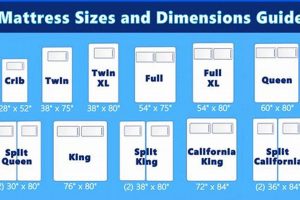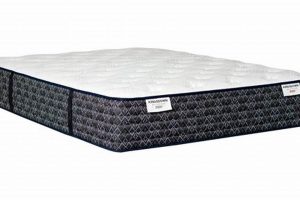The terms “full” and “double” when referring to mattresses describe the same size. A mattress designated as either a full or a double has standard dimensions of approximately 54 inches wide and 75 inches long. This sizing is intended to comfortably accommodate one adult or potentially two smaller individuals, although it can be a tight fit for couples.
The relevance of understanding mattress sizes lies in selecting the appropriate bedding and ensuring adequate sleeping space. Historically, this size emerged as a step up from a single or twin mattress, offering more room without the increased footprint of a queen or king. This makes it a practical option for smaller bedrooms or for individuals who desire more personal space than a twin bed provides.
The subsequent discussion will delve into factors to consider when choosing between mattress sizes, exploring their suitability for different sleepers, room sizes, and budgetary constraints. A detailed comparison will highlight key differences between this size and other common mattress dimensions, providing a comprehensive guide for informed decision-making.
Guidance on Mattress Size Terminology
This section addresses potential confusion surrounding mattress size designations. “Full” and “double” are often used interchangeably, yet awareness of their shared meaning is crucial for informed purchasing decisions.
Tip 1: Clarify Terminology with Retailers. Confirm dimensions with the seller. While “full” and “double” typically refer to the same size, variations can exist. Verify the exact width and length (approximately 54″ x 75″).
Tip 2: Understand Intended Occupancy. A “full” or “double” size is optimally suited for a single adult. Couples may find it restrictive, potentially impacting sleep quality. Consider larger sizes if sharing the bed regularly.
Tip 3: Measure the Bedroom Space. Accurately measure the room before purchasing any mattress. Ensure sufficient clearance for movement around the bed and for opening doors and drawers. Visualize the bed in the room.
Tip 4: Account for Bedding Requirements. Understand that “full” or “double” size sheets and bedding are specifically designed for these dimensions. Using improperly sized bedding can lead to discomfort and premature wear.
Tip 5: Compare Prices with Other Sizes. Examine the price difference between “full/double” and larger mattress sizes (queen or king). Evaluate if the increased sleeping space of a larger mattress justifies the additional expense.
Tip 6: Research Mattress Brands. Different mattress brands may have subtle variations in their interpretation of “full/double.” Consult product specifications and reviews to gain a comprehensive understanding of the actual size.
Tip 7: Consider Future Needs. Evaluate potential changes in sleeping arrangements (e.g., a partner). A “full/double” may suffice initially but could become inadequate as needs evolve. Planning ahead can prevent future expenses.
Accurate interpretation of mattress size terminology, particularly the equivalence of “full” and “double,” enables a more effective and satisfying mattress selection. Understanding these key considerations will facilitate purchasing decisions tailored to individual needs and spatial constraints.
The article will conclude with a succinct summarization of the comparative advantages and disadvantages of each mattress size discussed, furthering the reader’s capacity for informed decision-making.
1. Identical Dimensions
The premise of whether a “full” and “double” mattress designation indicates the same product hinges fundamentally on their physical dimensions. “Identical dimensions” are the cornerstone defining their equivalence. If two mattresses labeled differently share the same length, width, and height specifications, the distinction between the terms becomes purely semantic. For example, a mattress marketed as “full” measuring precisely 54 inches by 75 inches, and another labeled “double” adhering to the same measurements, represent the identical product size, regardless of labeling.
The practical significance of recognizing the “identical dimensions” is significant for consumers. It simplifies the selection process and prevents confusion arising from inconsistent marketing terminology. Knowledge that these terms describe the same size allows consumers to focus on other differentiating factors, such as mattress material, firmness, and construction, rather than getting bogged down in size nomenclature. Moreover, understanding this equivalence ensures compatibility with existing bedding sheets, blankets, and mattress protectors designated for either “full” or “double” will fit interchangeably.
However, the concept of “identical dimensions” necessitates careful verification. Subtle variations, even within the same nominal size, can exist across different manufacturers. To mitigate this risk, consumers should prioritize verifying the specific dimensions (width and length) detailed in the product specifications rather than solely relying on the “full” or “double” label. This diligence is paramount for ensuring a proper fit and avoiding potential issues with bedding compatibility and overall sleep comfort.
2. Interchangeable names
The designation of “full” and “double” as interchangeable names is central to understanding whether they refer to the same mattress size. This equivalence suggests a semantic relationship where the terms function as synonyms, implying shared dimensional properties and intended use.
- Market Usage
The marketplace commonly uses both terms to denote a mattress measuring approximately 54 inches wide by 75 inches long. Retailers may label identical mattresses with either designation, reflecting a widespread acceptance of their interchangeable meaning. This usage minimizes consumer confusion when searching for a mattress within these dimensions.
- Historical Context
The interchangeable nature may stem from historical practices where “double” described a mattress larger than a “single” or “twin,” capable of accommodating two individuals, though with limited space. As mattress sizes evolved, the term “full” gained traction, but the underlying dimensions remained consistent, leading to their synonymous application. This historical context contributes to the continued ambiguity and interchangeability present today.
- Bedding Industry Standards
The bedding industry generally designs sheets, comforters, and other accessories under the assumption that “full” and “double” are synonymous. This standardization streamlines manufacturing and simplifies the purchasing process for consumers. The industry’s implicit recognition of their equivalence reinforces their interchangeable use.
- Potential for Confusion
While generally interchangeable, discrepancies can arise. Some manufacturers might deviate slightly from the standard dimensions, using either term to signify a marginally different size. Consumers should exercise caution and verify exact dimensions to avoid unintended compatibility issues with existing bedding. A thorough evaluation of product specifications is always recommended.
The pervasive use of “full” and “double” as interchangeable names streamlines mattress selection, reflecting an industry-wide acknowledgment of their dimensional equivalence. However, consumers should maintain vigilance and prioritize verifying actual dimensions to mitigate potential discrepancies and ensure compatibility with bedding accessories.
3. Standard measurements
The equivalence of “full” and “double” mattresses is directly linked to adherence to standard measurements within the bedding industry. Consistent dimensions are the primary determinant of whether these terms describe the same product. Deviation from these standards introduces ambiguity and negates the interchangeable nature of the terms.
- Width Specification
The accepted standard width for both “full” and “double” mattresses is approximately 54 inches. This measurement provides sleeping space adequate for a single adult, allowing for reasonable movement and comfort. Any significant variance from this width necessitates a reevaluation of whether the mattress legitimately qualifies as either a “full” or “double.”
- Length Specification
Correspondingly, the standard length for these mattresses is approximately 75 inches. This length aims to accommodate individuals of average height. A length discrepancy could result in discomfort for taller individuals and might indicate a non-standard size that is neither strictly a “full” nor a “double,” but potentially a custom or altered dimension.
- Thickness Variability
While width and length are critical, mattress thickness can vary significantly without affecting its classification as either “full” or “double.” Thickness is primarily a function of construction materials and comfort layers, not dimensional designation. A “full” mattress can range from a thin profile to a significantly thicker “pillow-top” design without altering its core “full” or “double” identity, provided the width and length remain standard.
- Impact on Bedding Compatibility
Adherence to standard measurements is paramount for bedding compatibility. Sheets, blankets, and mattress protectors marketed for “full” or “double” mattresses are designed to fit dimensions of approximately 54 inches by 75 inches. If a mattress deviates from these dimensions, consumers may encounter difficulties finding appropriately sized bedding, highlighting the importance of dimensional conformity for practical usability.
In conclusion, standard measurements form the definitive basis for equating “full” and “double” mattresses. While thickness can vary, consistent width and length are essential for maintaining the interchangeable nature of these terms and ensuring compatibility with standard bedding accessories. Discrepancies in either width or length undermine the equivalence and require careful consideration to avoid purchasing errors.
4. Single occupancy
Single occupancy serves as a key consideration when evaluating the suitability of “full” or “double” mattresses. The dimensional characteristics of these mattresses directly correlate with their capacity to comfortably accommodate one individual, thereby influencing purchasing decisions based on intended use.
- Adequate Space Provision
A “full” or “double” mattress, with dimensions around 54 inches wide and 75 inches long, provides sufficient sleeping space for a single adult. This allows for freedom of movement during sleep and reduces the likelihood of feeling confined. In contrast, a twin mattress may feel restrictive for some adults, while larger sizes could be excessive for individual use in smaller spaces.
- Spatial Efficiency
For bedrooms with limited square footage, a “full” or “double” mattress strikes a balance between providing adequate sleeping space and conserving room area. This size allows for other essential furniture, such as dressers and desks, to be accommodated without overcrowding. Individuals prioritizing space efficiency may find this size more appealing than larger options.
- Cost-Effectiveness
Compared to queen or king-size mattresses, “full” or “double” mattresses are generally more cost-effective. This includes both the initial purchase price of the mattress and the cost of associated bedding accessories. Individuals on a budget, particularly those living alone, may find this size to be an economical choice without compromising sleep quality.
- Suitability for Guest Rooms
In guest rooms intended for single occupants, a “full” or “double” mattress provides a comfortable and accommodating sleeping arrangement. It offers more space than a twin bed, catering to a wider range of guest sizes and preferences. This size represents a practical and versatile option for occasional use, providing a welcoming experience for visitors.
The concept of single occupancy directly informs the appropriateness of “full” or “double” mattresses. Their dimensions, spatial efficiency, cost-effectiveness, and suitability for guest rooms align with the needs of individuals sleeping alone, making them a practical and comfortable choice in various residential settings. These factors collectively reinforce the relevance of understanding intended occupancy when selecting mattress size.
5. Bedroom size
The dimensions of a bedroom exert a significant influence on the suitability of a “full” or “double” mattress. While the terms “full” and “double” generally denote the same mattress size (approximately 54″ x 75″), the physical constraints of a bedroom dictate whether such a mattress is a practical choice. A room that is too small will make a “full” or “double” mattress feel cramped, impeding movement and potentially impacting the room’s functionality. Conversely, a very large room might visually dwarf the mattress, creating an imbalance in the space. Therefore, bedroom size must be a primary consideration, and understanding this relation is critical for informed home furnishing.
Real-world examples illustrate this point. In a small apartment bedroom measuring 10 feet by 10 feet, a “full” or “double” mattress may leave only minimal space for walkways and other essential furniture items like a dresser or nightstand. This limited space can lead to inconvenience and a feeling of confinement. Conversely, in a master bedroom measuring 15 feet by 18 feet, a “full” or “double” mattress might appear disproportionately small, leading homeowners to opt for a queen or king-sized mattress to better utilize the available space. The selection of a properly sized mattress directly affects the overall ambiance and usability of the bedroom. Proper planning includes measuring the bedroom, accounting for the space required for movement and additional furniture, and then choosing the mattress size which best suits these requirements.
In summation, while “full” and “double” describe a specific set of mattress dimensions, the bedroom’s physical size ultimately determines the appropriateness of this size. Overlooking this interplay can lead to suboptimal space utilization and a less-than-ideal bedroom environment. The challenge lies in balancing sleeping space needs with the overall functionality and aesthetic of the room. A careful assessment of bedroom dimensions relative to the standardized measurements of “full” or “double” mattresses is paramount for creating a comfortable and functional living space.
6. Bedding compatibility
The interchangeable use of “full” and “double” mattress designations directly influences bedding compatibility. Because these terms denote mattresses with standardized dimensions of approximately 54 inches wide and 75 inches long, the bedding industry produces sheets, comforters, and mattress protectors designed to fit either label. The cause and effect are clear: recognizing the dimensional equivalence of “full” and “double” leads to simplified bedding selection, while a failure to recognize this equivalence can result in purchasing improperly sized bedding. Consider the practical example of an individual purchasing “full” sized sheets for a mattress labeled “double,” fully expecting them to fit correctly due to the standardized dimensions associated with both terms.
The importance of bedding compatibility cannot be overstated. Ill-fitting sheets can cause discomfort during sleep, reduce the lifespan of the bedding itself due to increased stress on the fabric, and detract from the overall aesthetic appeal of the bed. Moreover, the practical significance extends to ease of use: properly sized bedding is easier to put on and take off the mattress, streamlining the process of changing linens. Retailers capitalize on this standardization by often marketing bedding sets under the combined “full/double” designation, further emphasizing the link between these mattress sizes and their corresponding accessories.
In summary, the standardized dimensions associated with “full” and “double” mattresses are critical for ensuring bedding compatibility. Recognizing the equivalence of these terms allows for simplified and accurate bedding selection, promoting comfort, longevity, and ease of use. While slight dimensional variations may exist across manufacturers, adherence to these standards is generally consistent, making bedding compatibility a reliable indicator of the interchangeable nature of “full” and “double” mattress designations.
Frequently Asked Questions
This section addresses common inquiries regarding the dimensional characteristics and nomenclature of “full” and “double” mattresses, aiming to clarify any lingering uncertainties.
Question 1: Are the terms “full” and “double” used interchangeably in the mattress industry?
Generally, yes. The terms “full” and “double” are widely recognized as referring to the same mattress size, approximately 54 inches wide and 75 inches long. However, it is always prudent to confirm exact dimensions with the retailer or manufacturer.
Question 2: If “full” and “double” mattresses are the same size, why are there two different names?
The dual nomenclature likely stems from historical practices. “Double” historically signified a size larger than a “single,” while “full” gained popularity later. Despite the terminological evolution, the underlying dimensions converged, resulting in the current interchangeable usage.
Question 3: Should one expect variations in size between a “full” mattress and a “double” mattress from different brands?
Minor variations are possible, but adherence to the standard dimensions is typically maintained. It is recommended to review product specifications and customer reviews for detailed dimensional information to identify any potential discrepancies.
Question 4: Is bedding designed for a “full” mattress guaranteed to fit a “double” mattress, and vice versa?
In most instances, yes. Bedding manufacturers generally design their products to accommodate the standard dimensions associated with both “full” and “double” mattresses. However, confirming dimensions of both the mattress and bedding is advisable.
Question 5: Is a “full” or “double” mattress suitable for two adults?
While technically possible, a “full” or “double” mattress is generally considered more comfortable for single occupancy. The available sleeping space may feel restrictive for two adults, potentially impacting sleep quality. Larger mattress sizes are typically recommended for couples.
Question 6: How does the cost of a “full” or “double” mattress compare to that of a queen or king-sized mattress?
“Full” or “double” mattresses generally have a lower price point than queen or king-sized mattresses. This cost difference extends to associated bedding accessories, making them a more economical option for individuals or smaller spaces.
In summary, the terms “full” and “double” generally describe the same mattress size. While variations can exist, adherence to standard dimensions is common. Understanding this equivalence simplifies the mattress selection process.
The next section will address the selection criteria for choosing a proper mattress size and its placement considerations.
Conclusion
The preceding analysis confirms that the terms “full” and “double” mattress are the same. Standard dimensions of approximately 54 inches by 75 inches characterize both designations. This dimensional equivalence is a critical factor for bedding compatibility and informed consumer purchasing decisions, regardless of mattress brand.
While terminological clarity is essential, the ultimate determinant remains the precise measurements. Continued verification and adherence to industry standards will preserve the functional interchangeability of “full” and “double,” ensuring consumers acquire the intended product and maintain appropriate expectations. The dimensions serve as a key to comfort and space management.







![Best Plush Full Size Mattress [Guide] For Comfort Sleep Organic & Natural Mattress Buyer’s Guide: Non-Toxic Sleep Solutions Best Plush Full Size Mattress [Guide] For Comfort Sleep | Organic & Natural Mattress Buyer’s Guide: Non-Toxic Sleep Solutions](https://mattressworldpa.com/wp-content/uploads/2025/07/th-2793-300x200.jpg)